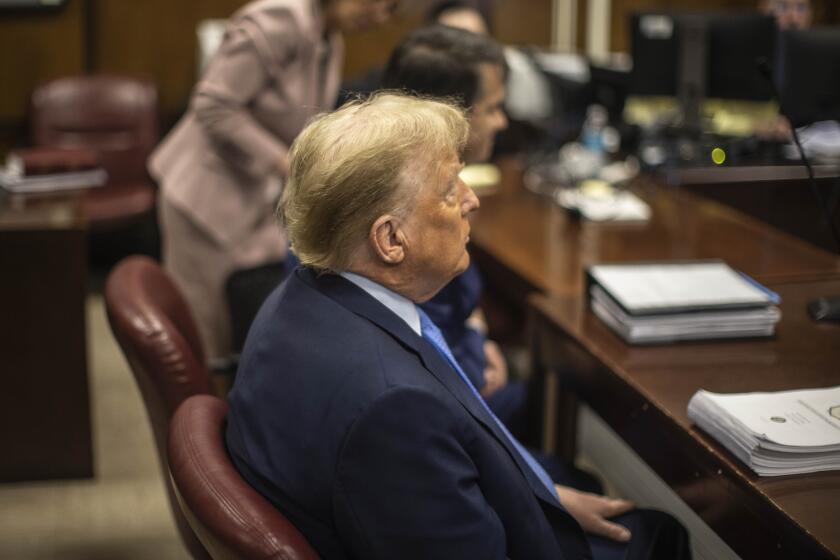A can-do president vs. a do-nothing mood
This just in: Americans don’t trust their government.
A spate of recent polls has found that faith in the federal government has sunk to near-record lows. In one survey, only 22% of those polled said they trust the federal government to do the right thing most of the time. More people said the federal government has a negative impact on their lives than said it has a positive one. Even relatively popular agencies such as the Defense Department and the Social Security Administration have seen their standings slip.
The last time those numbers sank so low was 1994, when then- President Clinton’s Democrats ran into trouble with voters over healthcare. In case you’ve forgotten what happened in that year’s congressional election, it was a Republican landslide.
What accounts for today’s sour mood? Just what you’d expect. The economy’s improvement has so far delivered early profits to Wall Street but little comfort to Main Street. The president who promised bipartisan solutions for the economy pushed through a healthcare bill that only one party supported. And in Congress, the two parties remain locked in nasty election-year bickering.
These problems aren’t all Obama’s doing, of course. The economy pitched into recession long before his inauguration. Republican leaders in Congress deliberately polarized the legislative branch. And trust in government has been on a gradual decline, with only periodic remissions, for decades.
But Obama’s policy choices have made the problem sharper. In 2008, before his election, voters split evenly on whether they wanted a bigger government with more services or a smaller government with fewer services. This year, it’s not even close: in a Pew Research Center poll released this month, 50% said they want smaller government and only 39% said they wanted bigger government. The voters’ newly conservative cast has even led to an uptick on noneconomic issues: More voters say they want to increase restrictions on abortion and decrease regulation of guns.
“People are going in a conservative direction in reaction to a president they perceive as liberal,” said Andrew Kohut, who directed the poll.
No matter who is to blame, the public’s anti-government mood has become one of Obama’s biggest problems. And the consequences extend well beyond the likely drubbing his Democrats will suffer at the polls in November.
Obama still has an ambitious agenda he’d like to enact, including financial sector regulation, energy legislation and education and immigration reform. He still needs to implement his landmark healthcare reform law. And looming over all these is the federal government’s growing fiscal crisis: Social Security and Medicare spending is about to soar while tax revenues lag.
If voters don’t think the federal government is capable of solving problems, Obama is going to have a hard time winning their support for higher taxes and lower benefits — sacrifices that are necessary for a better future.
In a sense, Obama is a victim of his own initial achievements. In his first 15 months, he focused on enacting ambitious new programs, and largely succeeded. Shoved to a back burner, partly because of the recession, was the “conservative” side of his agenda: fixing the deficit and making government more efficient.
Obama’s strength, so far, has been in designing big initiatives and using his Democratic majority to enact them. His weakness has been in politics: convincing voters that these were good things to do.
That’s quite a shift from our last Democratic president. Obama has passed big things and gotten little public credit. Clinton passed small things but managed to extract every possible ounce of public appreciation for them. It helped enormously, of course, that Clinton’s first term coincided with/ended in a robust economic recovery. By the time he faced reelection in 1996, the public’s trust in government — and in him — had rebounded nicely from its 1994 low.
Part of the reason was that Clinton (putting aside his Oval Office improprieties) seemed to know instinctively what would play well with voters. In his very first months in office, Clinton launched a highly visible project to “reinvent government” and put Vice President Al Gore in charge. Gore attacked the assignment with wonky zest. At one point, he demolished an ashtray on the David Letterman show to demonstrate the lunacy of procurement requirements.
The project was part management science, part vaudeville — and all politics. It was aimed deliberately at voters who didn’t trust the federal government, attempting to show them that the government could actually reform itself. When Clinton ran for reelection in 1996, one of his favorite pitches to voters was that he had reduced the size of the federal bureaucracy to its lowest level since John F. Kennedy.
The Obama administration has a similar initiative, called “modernizing government,” but you’ve probably never heard of it. It’s hidden in the Office of Management and Budget under a team of former corporate wizards, including the federal government’s first-ever “chief performance officer.”
They are smart people with good ideas, some of which have even been implemented. (Applicants for citizenship can now track their application status on a website.) Others have stalled. (“If you can book dinner [at a restaurant] online, then why shouldn’t you be able to make an appointment at your local Social Security office the same way?” Obama asked at a White House conference in January. You still can’t do it.)
Obama’s worthy “modernizing government” effort hardly matters if it’s invisible to all those voters who don’t trust their government to do anything right. Maybe it’s time to smash an ashtray or two.
More to Read
Get the L.A. Times Politics newsletter
Deeply reported insights into legislation, politics and policy from Sacramento, Washington and beyond. In your inbox three times per week.
You may occasionally receive promotional content from the Los Angeles Times.







